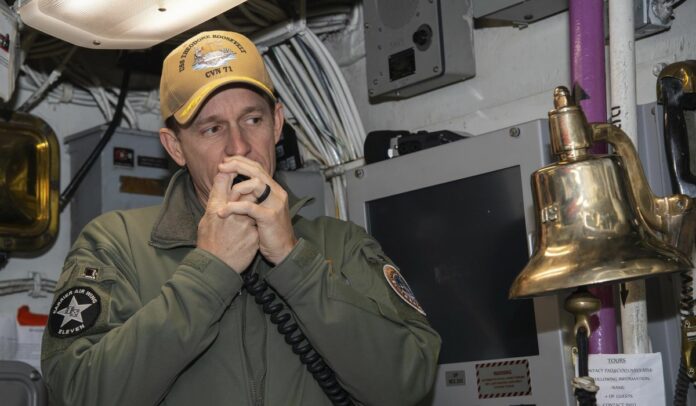The U.S. Navy on Friday upheld the firing of Capt. Brett E. Crozier, who was relieved of his command aboard the USS Theodore Roosevelt after a letter he wrote pleading for help for his coronavirus-stricken crew was leaked to the media.
The former commanding officer of the coronavirus-stricken aircraft carrier was more focused on the comfort of his crew than their safety, the chief of naval operations said.
Capt. Crozier was fired in April after a letter he wrote complaining about the conditions aboard his ship, warning that the situation on his vessel was dire and that sailors would likely die without a stronger response, was leaked to the press.
Navy Chief of Operations Michael Gilday, who briefed reporters at the Pentagon about the results of the two-month naval investigation, said the letter was not the reason for his decision to uphold the firing.
“We place a great amount of trust and confidence in our commanding officers and rely on them to manage risk, make decisions and to communicate openly and honestly with their chain of command — especially in a crisis,” Adm. Gilday said.
Capt. Crozier is now at a desk job in San Diego. He is not eligible for further command, Adm. Gilday said.
Rear Adm. Stuart Baker, commander of the carrier strike group and Capt. Crozier’s immediate superior, also was faulted for his role in the incident. Adm. Gilday said his promotion to two-star admiral has been put on hold.
Adm. Gilday said there seemed to be a “paralysis” in the command team aboard the ship. The moves effectively cut short the careers of both men.
“When obstacles arose, both failed to tackle the problem head-on and to take charge,” he said.
The Navy investigation found that Capt. Crozier mismanaged the initial outbreak on the ship. Some of his decisions may have added to the spread of the virus, Adm. Gilday said.
“They were slow egressing sailors off the ship. They failed to move sailors to available, safer environments quickly,” he said.
In a statement later Friday, Pentagon officials said Defense Secretary Mark Esper stands firmly behind the Navy’s decision.
“The secretary of the Navy briefed Secretary Esper earlier today on the findings of the investigation into the USS Theodore Roosevelt COVID response,” said Pentagon spokesman Jonathan Hoffman. “Secretary Esper believes the investigation to have been thorough and fair and supports the Navy’s decisions based on their findings. We are proud of the crew of the USS Theodore Roosevelt and am glad that they are back at sea in the western Pacific projecting American power.”
Navy officials said the coronavirus likely came aboard the ship during a scheduled visit to the port of Da Nang in Vietnam. But they have yet to identify a “Patient Zero.”
The three-star commander of the Navy’s 7th Fleet told Capt. Crozier to devise a plan to get the crew off the ship once it pulled into Guam. Adm. Gilday said he didn’t receive it until the day Capt. Crozier was relieved, about a week into the stop on the island.
“I was not impressed with the slow egress off the ship,” he said. “Both Adm. Baker and Capt. Crozier fell well short of what we expect of those in command.”
He was fired by former acting Navy Secretary Thomas Modly, who himself resigned days after flying to Guam and giving a profanity-laced speech to the crew aboard through the public address system, during which he lambasted their former commander.
When Capt. Crozier sent his emotional letter asking for help with the outbreak, discussions were already well underway between the Navy and local officials in Guam.
“When he hit ‘send’ on that email, six hours before, the governor of Guam had already agreed to allow us to use hotel rooms,” Adm. Gilday said. “He felt we weren’t moving fast enough but those wheels were already in motion.”
He said Navy officials in Guam had “moved mountains” to find safer spaces for the crew even before the hotels were pressed into service. But Capt. Crozier apparently wasn’t satisfied with their efforts, officials said.
“Although it wasn’t individual rooms, it was the best that we had,” Adm. Gilday said. “They were placed six feet apart and 72 square feet were allocated for each sailor.”
He said vacant housing and barracks on base also were ready to house the sailors.
“On the day that Crozier sent the email, there were 700 beds unfilled,” Adm. Gilday said.
About 1,200 sailors aboard the ship eventually tested positive for the coronavirus.
Adm. Gilday also faulted Capt. Crozier for a decision to release sailors from quarantine in the rear section of the ship.
“It put his crew at higher risk and may have increased the spread of the virus,” he said.
After an initial investigation, Adm. Gilday said he thought Capt. Crozier should be reinstated to his command. But that changed after the more complete inquiry.
“Had I known then what I know today, I would not have made that recommendation to reinstate Capt. Crozier,” he said. “Moreover, if Capt. Crozier was still in command today, I would be relieving him.”
The USS Theodore Roosevelt returned to sea last month under the command of its new captain.






